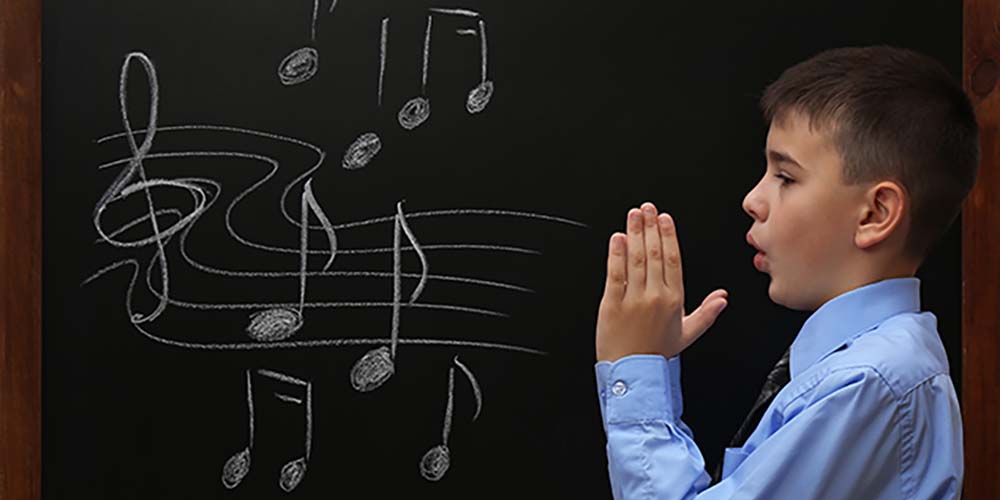Pitch refers to the height or depth of a sound. Notes in music are playing in relation to one particular sound. When a guitar player tunes their guitar, for example, he is trying his one fixed sound and make it the exact tone he wants. This is how you find pitch when singing as well. Find the base sound and determine all of your variations based on that root note. Some people are born with an ear for music and possess natural talent, but most singers need to learn and practice. Once a singer becomes finely tuned with their pitch, they will be able to sing all the notes within a scale or chord without sounding flat or sharp. Until you get there, use these basics to help get you started.
Look to the Piano
If you want to know what notes the human vocal chords are capable of, look no further than the piano. All singing voices and instruments use the notes of the piano. Piano notes produce a fixed sound that fades away but never changes pitch. Many instruments including the human voice are capable of producing an almost infinite number of fixed sounds between any two notes on a piano with only the slightest variations between them.
For a specific example, the A note and the G note sit next to each other on the piano (G sits immediately left of A). If you play an A note and follow it with a G note, the second note will be a lower pitch than the first. Conversely, if you play an note A note followed by a B note (directly to the right of the A), the second note will have a higher pitch than the first.
Proper Singing Pitch for Different Instruments
Different instruments are tuned to a different pitch. Many people end up singing off key because they do not properly adjust to the fixed note of a particular instrument. Each instrument is slightly different but use this guide to help you find your perfect singing pitch for each one.
- Guitar - Guitarist generally use E for their base tuning.
- Piano/Keyboard - Middle C is the standard base note for piano and keyboard players alike. Middle C is the C closest to the center of the piano.
- Orchestra - Orchestral players typically use A as their base note. The standard A note is located immediatly to the right of middle C
To help you train your singing voice for proper pitch, practice the pitch of these different instruments. The best way to practice is by simply striking the corresponding key on the piano and allowing your voice to resonate with the pitch of the note. When you do these in tandem, you will be able to hear whether your pitch is too sharp or too flat. After a bit of practice, your ears will help you find the exact match in pitch.
Pitch Training

You are not tone deaf! Many people label themselves as "tone deaf" but only a very small percentage of people actually are. Some people simply have an easier time identifying notes (without listening to them) than other people do. The key to recognizing pitch (along with notes, chords, and intervals) is repeated listening and singing back. Ideally you need a teacher to help you identify your progress but there are some things you can do when a singing teacher isn't available.
- Play the Note - Play the note you are trying to sing on an instrument. Once again, the piano is best for this but you can use your guitar if there isn't a piano nearby. Stay away from brass instruments when doing this exercise. You want to be able to focus on the note, not having to play the note which is more complicated with brass instruments.
- Listen To the Note - It is important when you first play your note that you do not sing along with it. The first strike of the note is for listening only. Allow your ears to hear the note and find its pitch before attempting to match it with your voice.
- Play and Listen - Now combine the two steps listed above. Play your note and simultaneously match your pitch to the note. You can get a recording device if you're still having a difficult time telling whether or not you've got it. Play, record, and listen until you are able to match your key. Repeat this exercise with each note going up and down the scale and use this as a building block before you move on to the next exercise.
- Grab your favorite song and record yourself singing along to it. When you listen to the recording, take notice of how you sound. Is your singing melodic? Do your notes and tone match the singer or are they harsh and off key? Ask yourself these questions and practice over and over again. Go back to the piano to find the pitch of the sound if you're having trouble. Play the note on the piano over and over again until you are able to match your voice to the pitch. Keep this pitch in your head and record yourself singing your favorite song again until your voice and pitch match the song. You may find that you have to do this several times before you get it right which is why we suggest picking a song you like.
